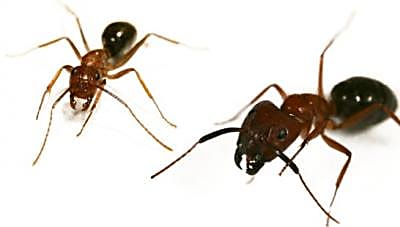Single cell RNA-seq reveals the underlying biology differentiating foragers and soldier ants
The pests that plague us may also be the creatures that most fascinate us. Ants fall into that category, earning our curiosity because of their extraordinary biomechanical abilities and social organization; yet also causing headaches when the summer weather compels them to march upon homes and backyard BBQs in search of food and shelter.
We’ll take a break from the conversation around how to get rid of our ant cohabitants, and, for this blog, explore the underlying biology of one ant species’ social hierarchy. According to insights from single cell RNA-sequencing (scRNA-seq) analysis of Florida carpenter ant (Camponotus floridanus) brains, a hormone-degrading enzyme—juvenile hormone esterase (Jhe)—that operates within the ant equivalent of the blood–brain barrier (BBB) drives the behavioral and physiological divergence of Minor and Major worker ants. As their names suggest, the smaller Minor workers support foraging and brood care, while the larger Major workers defend the nest (1).

Keep reading to see how single cell analysis enabled this discovery, and continue exploring our blog series highlighting cool biology in non-model organisms, from spiders to axolotls.
A single cell ant brain atlas
In order to define the cell types and gene expression programs that may contribute to the physiological and behavioral divergence of C. floridanus foragers and soldiers, researchers from the University of Pennsylvania performed scRNA-seq on central brains from early adult Major and Minor ants (1). This revealed 19 cellular subclusters, including conversed neuronal and glial cell types validated by referencing single cell datasets from another ant species. Comparing their results to single cell data taken from ants at a mature adult stage, the team observed a population of newly born or actively differentiating neurons that were likely unique to the early adult developmental stage. Additionally, they observed clear separation of functional glial cell types, including astrocyte-like glia, ensheathing glia, surface glia, and cortex glia, representing the four major glial cell types previously identified in the insect central brain.
Single cell analysis revealed a pattern of differential gene expression between Major and Minor ants for several known genes associated with social caste behavior, including the Major-biased cfJhe and Jheh genes, which encode JH3 esterase hydrolases—enzymes responsible for processing the juvenile hormone JH3. Notably, Major ant brains had clear preferential expression of caste-associated genes in glial cell types, suggesting glial cells play an important role in establishing the gene expression profile of Major ant brains.
Glial cells expressing hormone-degrading enzymes in the blood–brain barrier distinguish foragers and soldiers
JH3 is an important hormone in ant behavioral and physiological development because it triggers foraging in Minor workers. Going deeper into their observations of the preferential expression of genes that encode enzymes that degrade JH3 in Major ants, the research group observed upregulated expression of cfJhe in a subcluster of surface glial (SG) cells. Importantly, these cells are known to compose the insect brain structure functionally analogous to the mammalian blood–brain barrier (BBB)—a cellular barrier that prevents contact between the brain and the insect equivalent of blood (circulating hemolymph). Additional cell surface markers biased to this SG cluster were also associated canonically with perineurial glia, which would likely constitute the peripheral layer of the ant BBB.
Given these observations, the team concluded that this important glial cell type is likely driving the degradation of juvenile hormones that would otherwise trigger Minor ant behavioral phenotypes, and is, therefore, encouraging the Major ant phenotype.
Additional unbiased insights powered by single cell analysis revealed specific factors driving Minor ant behavioral divergence as well. Interestingly, the team observed upregulated expression of another hormone-regulating gene, nolo (no longer nerve cord), in the perineurial glia cell population in Minor ant brain samples. This gene is associated with the neuronal lamina extracellular matrix known to restrict the size of the central nervous system (CNS), suggesting nolo activity works to form the CNS to fit a Minor ant body plan.
These fascinating insights into ant physiology and behavior collectively point to the value of unbiased single cell analysis to unearth the cell type–specific gene expression programs that drive observed biology, providing greater depth to our ongoing study of the genotype–phenotype relationship at the scale of individual cells, but also at the scale of functionally divergent members of an animal population.
Learn more about Chromium Single Cell Gene Expression. And read our other blogs highlighting cool biology in non-model organisms, including spiders, axolotls, and octopi.
References:
- Ju L, et al. Hormonal gatekeeping via the blood-brain barrier governs caste-specific behavior in ants. Cell 186: 4289–4309 (2023). doi: 10.1016/j.cell.2023.08.002
About the author:

